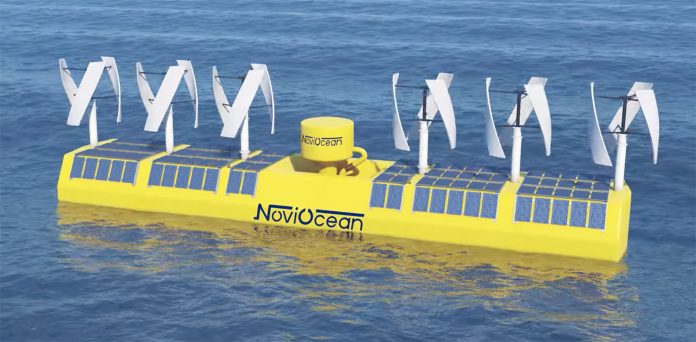A Swedish company, NoviOcean by Novige, is making strides in renewable energy with a hybrid power plant that harnesses wave power, wind power, and solar energy. The innovative design recently won the Startup4Climate competition, highlighting its potential to contribute significantly to sustainable energy solutions. Founder and CEO Jan Skjoldhammer envisions scaling up the technology in collaboration with offshore wind farms to maximize its impact.
An innovative approach to renewable energy
NoviOcean’s CEO, Jan Skjoldhammer, accepted the Startup4Climate award alongside Cemvision, a company producing fossil-free cement. The jury was impressed by the hybrid power plant’s ability to combine three renewable energy sources—wave power, wind power, and solar energy—that complement each other effectively.
While wave power has historically presented challenges, with many companies struggling to develop successful wave power plants, Skjoldhammer believes NoviOcean’s technology stands out due to its robust and straightforward design. “What speaks for our success is the simple and effective technology and the fact that it is a hybrid that produces electricity from several energy sources,” he explains.
Design and functionality of the hybrid power plant
The NoviOcean wave power plant resembles a rectangular raft, measuring 38 meters in length and four meters in height at full scale. When deployed at sea, it aligns parallel to incoming waves. Beneath the power plant lies a water-filled cylinder equipped with a piston rod and a cable connected to the seabed. Four anchors extend from the sides of the raft to maintain its correct position on the water’s surface.
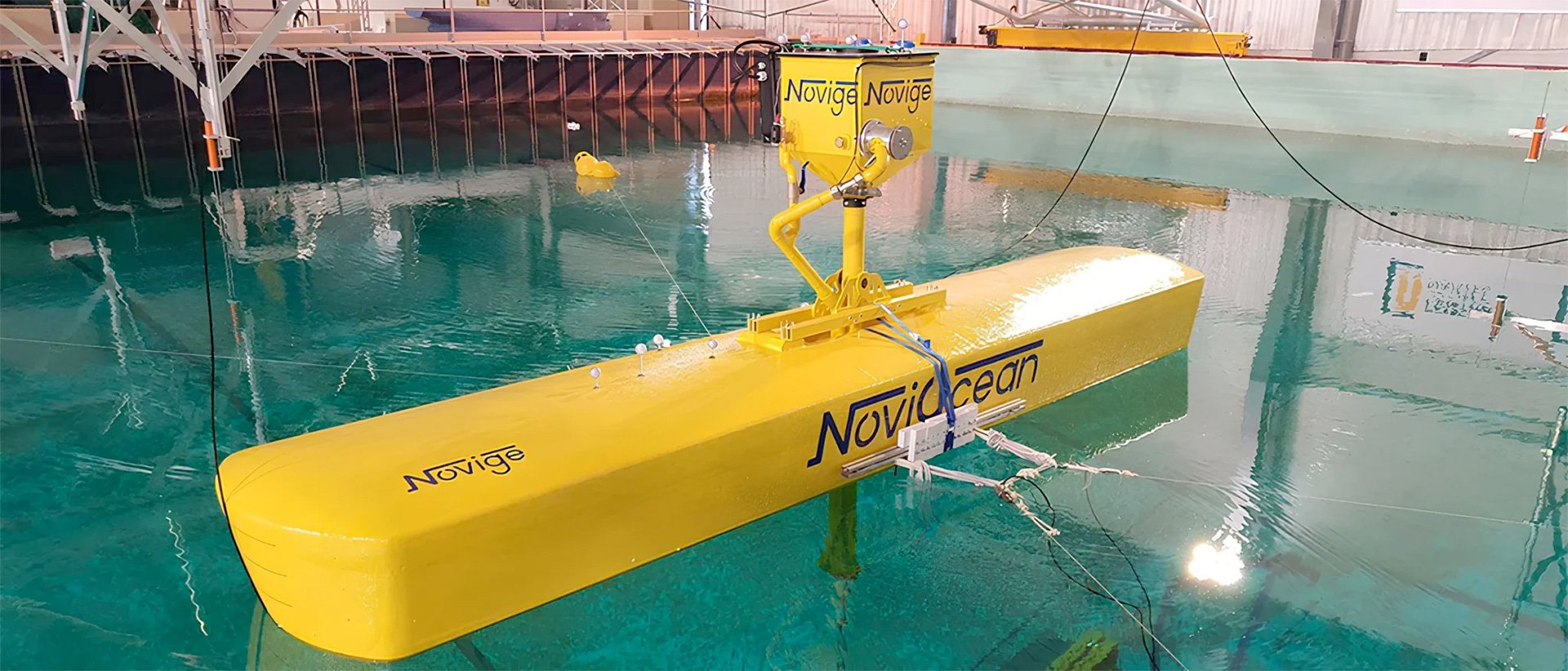
Atop the raft are six vertically oriented wind turbines that collectively generate 300 kW of power. Additionally, solar panels with a capacity ranging from 50 to 80 kW are installed on the raft. Combined, the hybrid system achieves a total capacity of approximately 1 MW, with an average capacity factor of about 40 percent.
Skjoldhammer describes the wave power component as operating on a principle similar to an old garden pump. “In the wave power plant itself, water is pumped in a circular flow in the cylinder. When the raft, which lifts with up to 600 tons, goes up, the water is also pumped up,” he says. Once elevated, the water is directed to a Pelton turbine at speeds reaching up to 300 km/h, with a flow rate of 800 liters per second. A generator connected to the same axle then converts this kinetic energy into electricity.
“The components of the wave power plant are based simply on a raft, a garden pump, and an upside-down hydropower plant,” Skjoldhammer notes. “Of course, we also have innovative technology to make this work optimally, and the technology is patented in 20 countries.”
Extensive testing and validation
NoviOcean’s technology has undergone rigorous testing over several years. Initial tests were conducted in wave pools in England and France to validate the concept. Subsequently, a 24-month testing phase took place in a test rig at the Royal Institute of Technology (KTH) in Stockholm. For the past year, a miniature version of the power plant has been operational in a real-world environment off the coast of Lidingö, Stockholm.
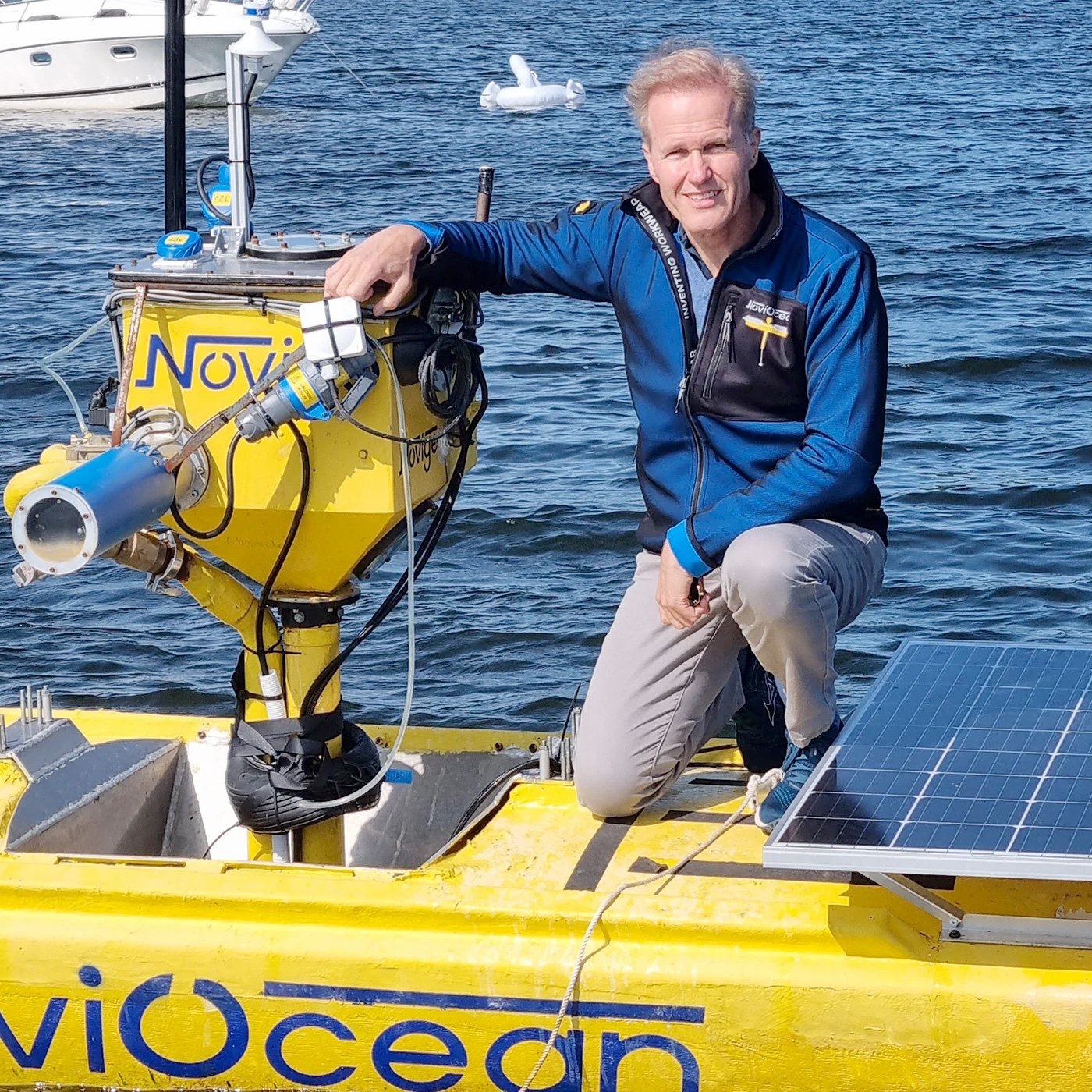
This scaled-down model, measuring six meters in length and capable of lifting about one ton, supplies electricity to homes on the small island of Svanholmen. “Here we see that the technology works at sea, as we have seen and validated in wave pools and in test rigs,” says Skjoldhammer.
Optimizing space and resources
One of the significant advantages of NoviOcean’s hybrid power plant is its efficient use of space and resources. “On one square kilometer, we can place 15 wave power plants with an output of 15 MW of electricity, while offshore wind power has an energy density of 10 MW,” Skjoldhammer explains. “Together we can get up to 25 MW, and we can share the costs for the sea area.”
The strategy involves situating multiple hybrid power plants near large-scale wind turbines. The electricity generated from these energy parks would be transported to land through a shared cable system. This approach not only reduces individual costs associated with sea area usage and infrastructure but also doubles the energy output within the same spatial footprint.
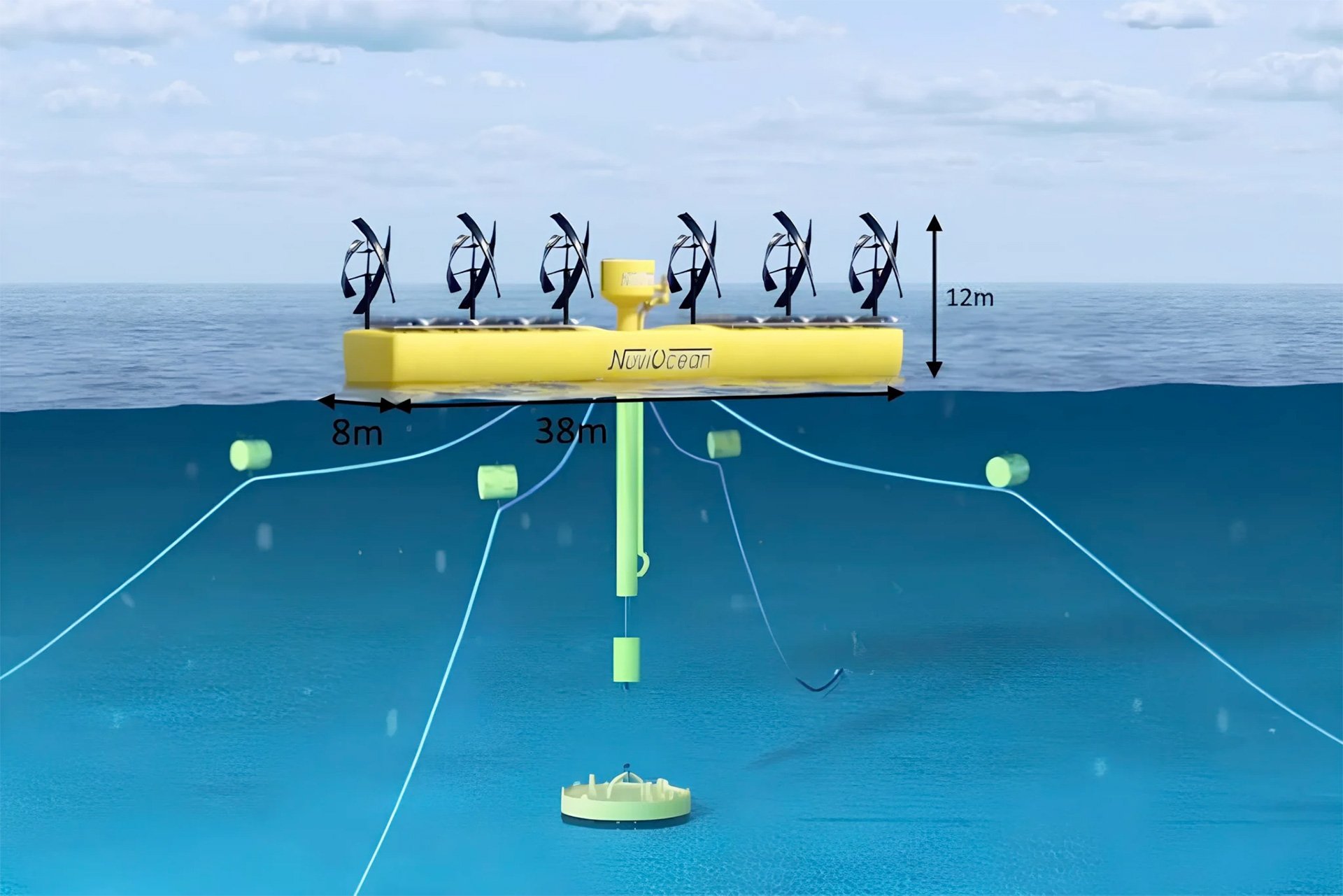
Moreover, the combination of energy sources offers a more consistent power supply. “It also gives a more even effect because the waves remain for several days after the wind has died down and then produce electricity during the time when the wind turbines are not producing as much,” Skjoldhammer points out. Additionally, standalone wave power facilities can be placed closer to shore without causing visual disturbances, offering an advantage over traditional wind farms.
Industry recognition and support
The potential of NoviOcean’s solution has not gone unnoticed. Johan Lindehag, a member of the Startup4Climate jury and CEO of Ellevio, expressed optimism about the technology’s impact. “In many ways, NoviOcean by Novige’s wave power solution has the potential to be significant for climate work and the energy transition,” he says. “Unlike other wave power, which is often both heavy and complicated, this is a solution that is both lighter and can produce a higher effect. It is simple and efficient, and it also adds solar panels and wind power.”
The Startup4Climate competition, organized by Ellevio and Godel, is in its fourth year and aims to identify innovative solutions with measurable climate benefits. Out of 75 entries, NoviOcean was one of two companies awarded the top prize, receiving one million Swedish kronor.
“For our company of seven people, the win means recognition from the energy industry—a kind of verification that what we are doing is right,” Skjoldhammer remarks. “This is the fifth time we have been praised by experts in energy and climate, and the fact that we get confirmation time and again that we are doing the right thing shows that we have potential.”
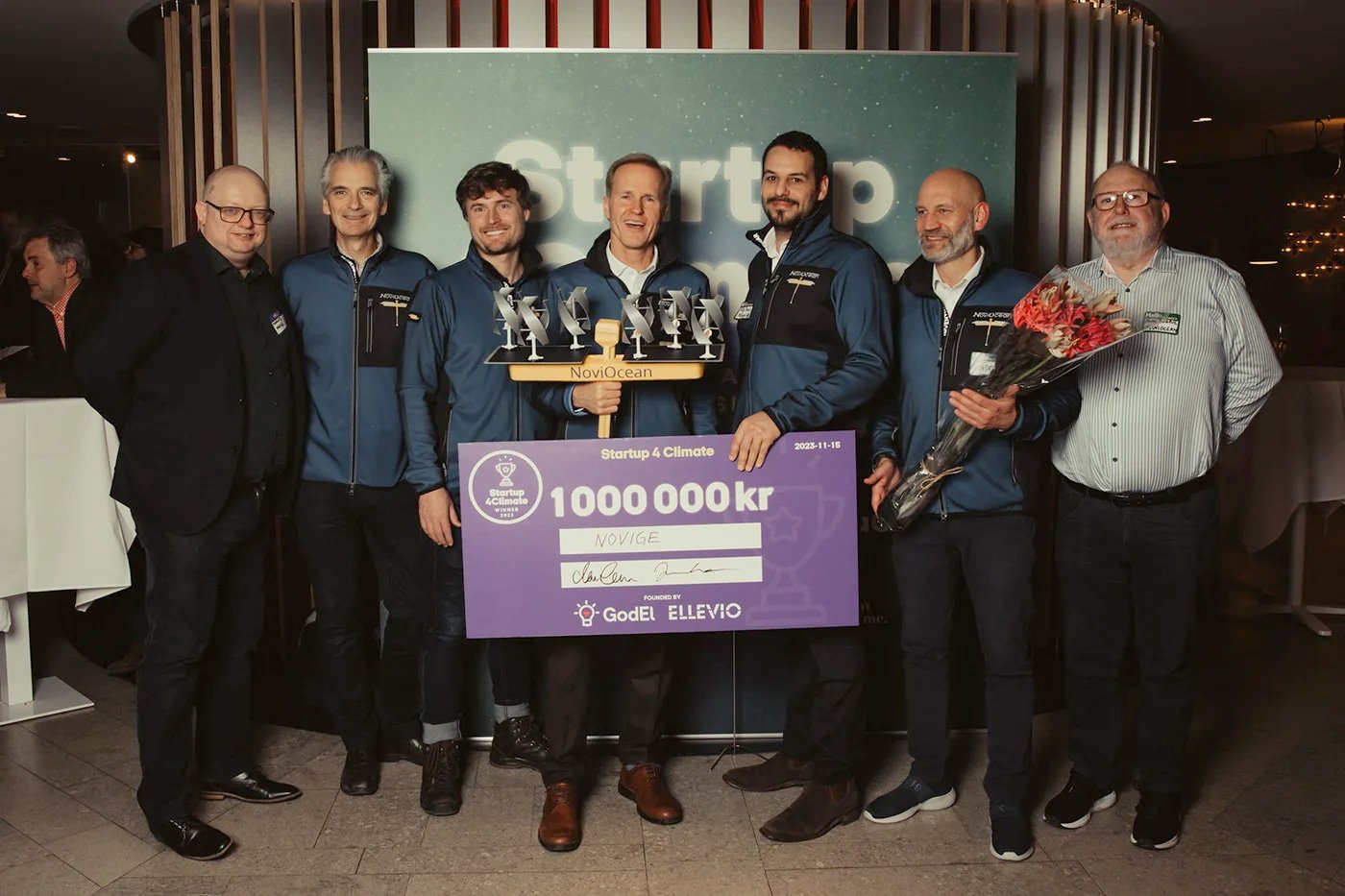
Looking ahead: Scaling up and international collaboration
The next phase for NoviOcean involves implementing a full-scale pilot project. The company is actively reaching out to major offshore wind power companies to explore partnerships for building a pilot offshore plant that integrates wave turbines, vertical wind turbines, and solar cells.
Given that Swedish waters lack sufficiently high waves for large-scale deployment, NoviOcean is considering locations along the large continental coasts, such as those off North and South America. However, Skjoldhammer sees opportunities closer to home as well. “Sweden can also take part in electricity produced from the wave power plants because off the coast of Norway there is a perfect combination of waves and wind for our technology,” he says. “Then the electricity could be delivered in the existing grid to Östersund and Karlstad. This way, we could provide stable and green electricity to SE3 and SE4.”
Challenges and funding
Despite the promising technology and industry recognition, NoviOcean faces challenges, particularly in securing sufficient capital for development and deployment. “The main challenge is capital,” Skjoldhammer admits. “We have received approximately SEK 30 million in grants from the EU and Sweden through, among others, the Energy Agency and Vinnova and have taken out a green loan from Almi. Now we get one million kronor through the profit from Startup4Climate.”
Developing and establishing new technology, especially in the renewable energy sector, is an expensive endeavor. “It is costly to work with the development and establishment of new technology,” he notes. “Now we very much hope to take the next step together with a company in wind power.”
Source: NoviOcean

